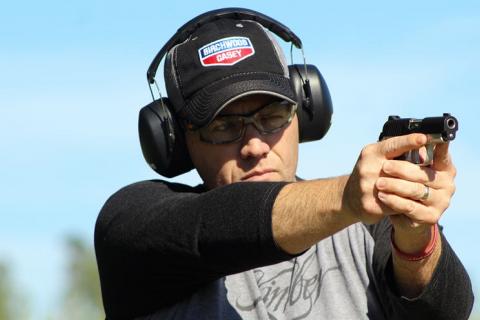
For several years, a quality handgun has been on the top of my most wanted gear list. With the need for a self-defense style handgun gaining popularity all over the world, I decided it was time to buy a new firearm. I chose one of the most popular calibers in handguns, which is a 9mm.

Auto Pistol
The particular model that I picked was the Kimber Ultra Carry ll Two Tone handgun simply because I have shot Kimber rifles for a couple of years now and I love the quality and performance that they provide. Plus, Kimber is well known as one of the top manufacturers in handguns.
After purchasing, I wanted to learn a few basic fundamentals of using my handgun for self-defense. I contacted my good friend Matt Trude of Birch Tree, Missouri. Trude has taught martial arts/self-defense for nearly 16 years and has been a certified NRA Handgun Instructor for 14 years. I asked Trude to help me with 3 important fundamentals that a person who is new to the handgun game should know.
1. How to Draw Your Firearm Properly
 Trude: "Drawing your firearm from a concealed holster must be done in the same manner each time. The non-shooting hand should grab the concealing garment and then go to the chest while obtaining a firing grip with the dominant hand. After clearing the holster, both hands punch straight out in a 2 handed grip."
Trude: "Drawing your firearm from a concealed holster must be done in the same manner each time. The non-shooting hand should grab the concealing garment and then go to the chest while obtaining a firing grip with the dominant hand. After clearing the holster, both hands punch straight out in a 2 handed grip."
Note: The majority of accidents occur when drawing your firearm from the holster, and/or putting the firearm back into the holster. This is why it is a must to learn the proper fundamentals of drawing a firearm.
2. Focus on the Front Sight Picture
Trude: "Focus on the front sight. Once you have obtained your 2-handed grip, overlay the front sight on the threat or target. The eyes can only have one focal point. The front sight, rear sight, and target will all be different distances from the eyes. The reason we pick the front sight is because it is telling us where the gun is aiming."
Note: Most defensive shooting scenarios occur at close distances, yet law enforcement and civilians alike have been known to miss an adversary as close as 10 feet. Front sight focus is critical.
What is a Sight Picture?: A sight picture is the pattern of the pistol sights in relation to the target as you aim the handgun. A correct sight picture combines correct sight alignment and correct aiming point
Tip: NRA Shooting Fundamentals Infographic

3. Gun Trigger - Press & Control
 Trude: "Notice how it says 'trigger press', not mash, slap, or jerk the trigger. The goal is to press the trigger of the gun smoothly and continuously to the rear of the trigger guard until the trigger breaks, without moving your grip. Slapping the trigger will cause most right-handed shooters to miss low and/or left. Remember you are in control of the gun, the gun is not in control of you."
Trude: "Notice how it says 'trigger press', not mash, slap, or jerk the trigger. The goal is to press the trigger of the gun smoothly and continuously to the rear of the trigger guard until the trigger breaks, without moving your grip. Slapping the trigger will cause most right-handed shooters to miss low and/or left. Remember you are in control of the gun, the gun is not in control of you."
Note: When practicing, use a target in which you can easily see where you are hitting, such as a Birchwood Casey Shoot-N-C Target. This type of target creates a bright chartreuse ring around the point of impact giving you the ability to easily see where you are hitting without moving from your shooting position.
Learning these three techniques is a great start for the beginning shooter who is wanting to learn how to shoot a handgun for sport of for self-defense. It is still recommended to take some type of training from a certified instructor to make sure you are shooting correctly and safely no matter the situation.
Tip: Always remember that you are responsible for every round that leaves the barrel of your firearm.
- Always keep your finger off of the trigger until ready to fire.
- Never point the muzzle at anything you're not willing to destroy.
- Know your target.... We do not shoot at scary sounds or shadows.

- 8131 views

